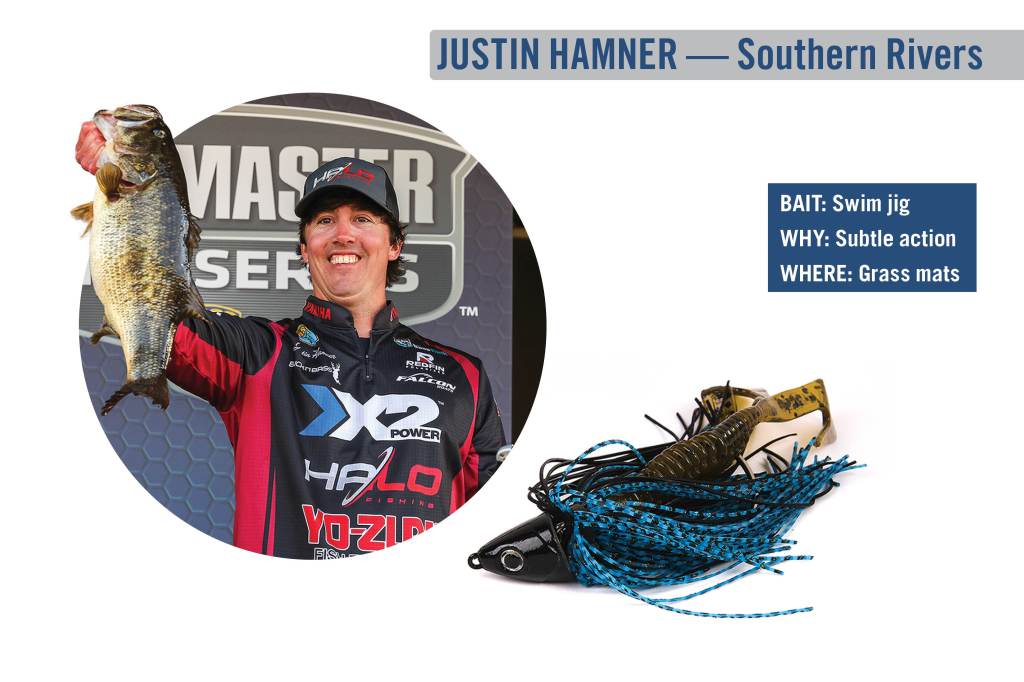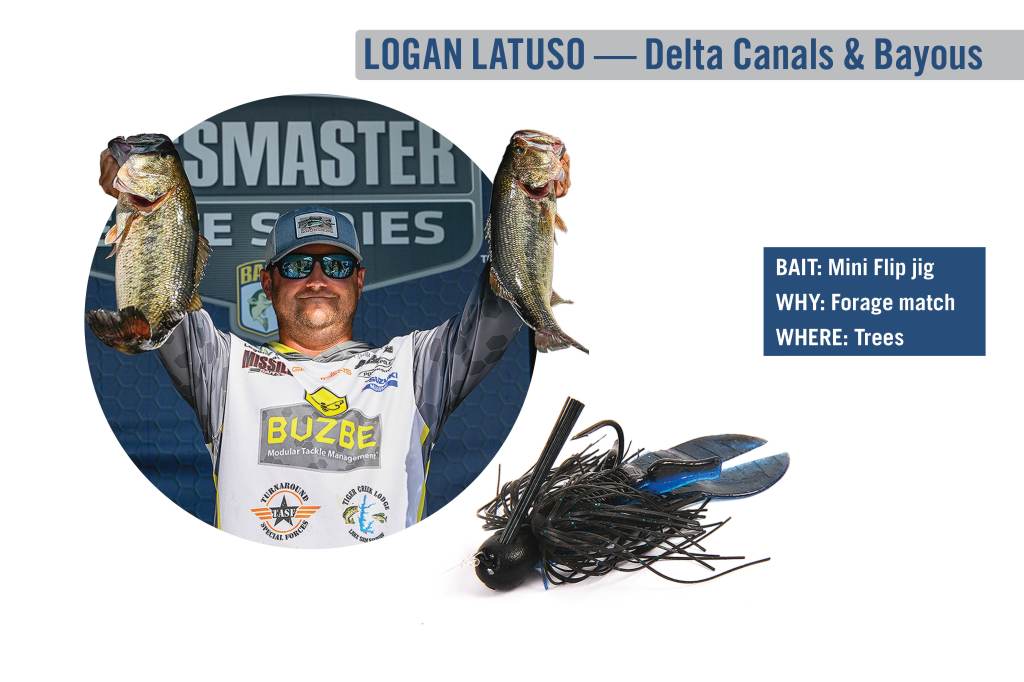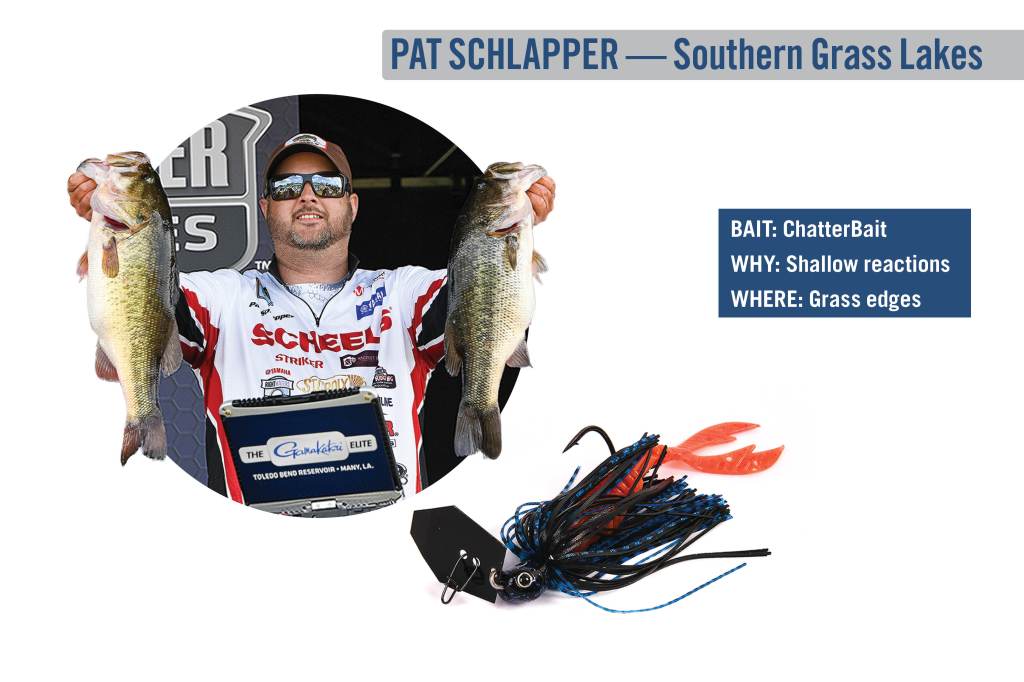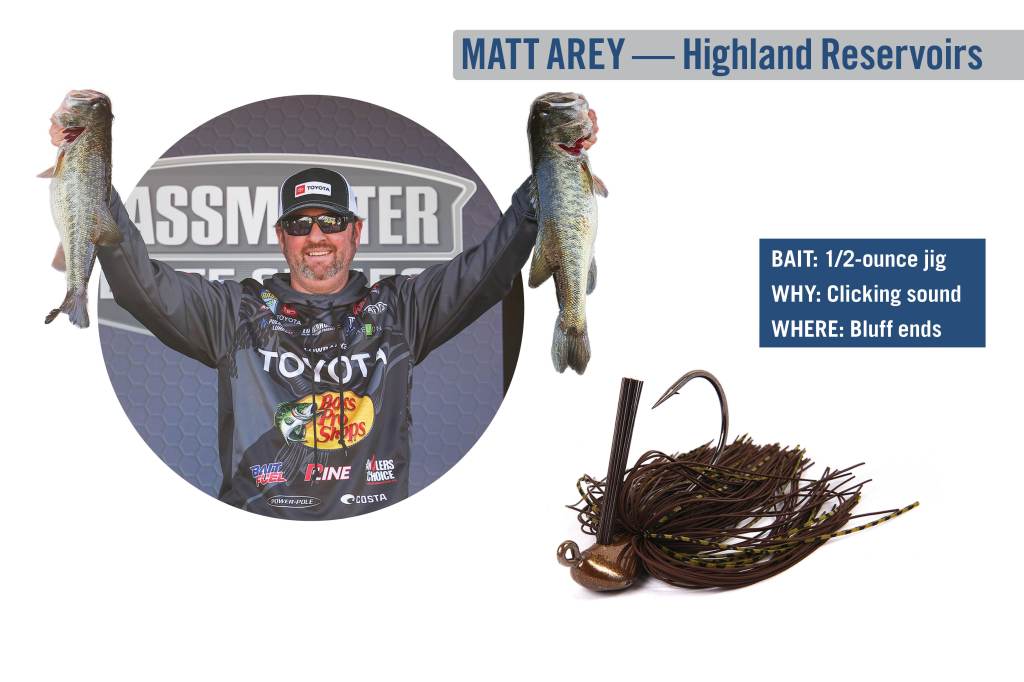
Though some see the winter months as a good time for hot chocolate and a roaring fire, anglers willing to brave the elements can score a personal best
The start of a new year brings hope and aspiration for another calendar’s opportunities. Among them, the hunt for the year’s biggest fish consumes most anglers’ focus. Four Bassmaster Elite Series anglers shared their insights into how they track down and engage giants in the wintertime.

Justin Hamner — Southern rivers
The reigning champ of the 2024 Bass Pro Shops Bassmaster Classic presented by Jockey Outdoors from Northport, Ala., won’t necessarily skip the early option during winter, but most days, he puts his faith in the afternoon warmth.
“After lunch, when the sun gets up, that’s going to be the key time,” Justin Hamner said. “I’m looking for the shallow bite. I may not get many bites, but if I’m going for the big ones, I’m looking super-shallow for the first females that are pulling up near areas where they’re going to spawn.
“I want a stable day, but having the sun out is usually the key. Those fish are cold and lethargic. They just want to get up shallow and warm up.”
Hamner’s looking for vegetation in deeper creeks. The fish he’s targeting have been holding in the creek bends, so flatter areas near these directional transitions afford shivering prespawners optimal areas to rise and tuck into the heat-holding vegetation.
“Around here, it’s water willow — usually the dead willow from the previous year,” Hamner said. “A lot of times, it will mat up and hold heat.”
In his experience, smaller patches of thick willow prove most promising. Add in a secondary vegetation element, such as pad stems, and that’s pure gold.
Hamner’s go-to reaction bait is a Freedom Tackle swim jig (black/blue for stained water, shad-colored for clear) with a Netbait Mini Kickin’ B trailer. The Mini Kickin’ B has less action than, say, Netbait’s Paca Craw, but that subtle look works well with Hamner’s winter presentation.
“I want the 1/4-ounce so I can work it super-slow,” Hamner said. “I’m not doing the usual right-below-the-surface retrieve; I’m really just throwing that bait right on the edge of the vegetation and trying to get through that cover, maintaining bottom contact.
“I do still shake the swim jig just to get that action — it might just be a habit. The key is maintaining contact with the bottom.”
Hamner trims his swim jig skirt by about half an inch. Keeping the skirt level with the bottom of the hook bend produces an enticing flare.
He fishes his swim jig on a 7-5 medium-heavy Halo KS II Elite rod, which provides plenty of fish-whipping power with enough sensitivity to feel light bites. Pairing this rod with a 7.1:1 reel carrying 50-pound braid, he’s confident he has the right outfit for the job.

Logan Latuso — Delta canals and bayous
If Logan Latuso tells you winter bass fishing in southeastern Louisiana is a dead-end deal, take him literally. As he explained, big prespawn bass move away from current and set up shop in wind-protected, hard-bank canals far from the main-river fluctuation.
Notably, Latuso expects to find his best opportunities by targeting “isolated, dominant cypress trees.” The logic is simple: Clustering trees create a shade line that minimizes sun exposure.
“I prefer a tree that’s farther out from the bank — the deeper, the better,” Latuso said. “Your bigger fish will get on them.”
Latuso mostly fishes areas far enough from tidal reaches that daily ebb and flow bear minimal impact.
“Even way down in Venice, La., [in the lower Delta], tide doesn’t really matter that much if you find a good high-bank canal where tide can’t really fluctuate [the water] as bad,” Latuso said. “If the water is over the bank, that’s never good because I feel like the fish go with it.
“That time of year, we just try to find the most stable canals. Those fish want to be somewhere they can do their deal without the water fluctuating.”
Noting that a 6-pounder is brag-worthy in southern Louisiana marshes, Latuso said he’s caught several pushing that mark on his top winter choice: a 1/2-ounce bruiser-colored Missile Baits Ike’s Mini Flip jig with a Missile Baits D Bomb trailer (cut in half to maintain a compact profile). A highly efficient bait for target fishing, the jig mimics the crawfish that Delta bass seek.
“I want to use something bigger to make the jig fall a little slower,” Latuso said. “That time of year, the water is colder, and the crawfish are really lethargic. I want that trailer to slow the jig down, and I’ll just drag it around those trees.”
Latuso complements the jig with a 1/2-ounce Delta Lures chartreuse/white spinnerbait with double Colorado blades. When the fish perk up with warming trends, he’ll slow roll his spinnerbait around those isolated trees.
Describing his jig technique, Latuso said, “I think the biggest thing is you want to make your jig land as quietly as possible. You want to stay back, but you want to make that jig slip into the water without making a ripple.
“When you’re working that jig, it’s almost like you’re just picking up the slack in your line; you just barely crawl that jig around that tree.”
And when Latuso says “around that tree,” he’s allowing a generous spacing. A common mistake, he said, finds anglers missing most of the high-value zone.
“A lot of those fish will be sitting off the tree,” he said. “With that cypress tree’s root structure, it’s like a 3- to 4-foot perimeter.
“Some people just pitch in toward the tree and then reel their jig in, but I like to work it out from the tree 3 to 4 feet. The fish will tell you if they want to be right on that tree or off it a little bit.”

Pat Schlapper — Southern grass lakes
What’s good about a “grass lake” — vast fields of submerged vegetation — may initially appear overwhelming, but Pat Schlapper’s discernment guides him to the big-fish potential.
“I want to find grass with hard bottom; usually it’s shell, but it could be rock or gravel,” he said. “Also, I prefer patchy grass, as opposed to just thick, matted grass. I think the fish are easier to access.
“I also think the big ones like that patchy grass because it’s easier for them to eat.”
The cold-weather months will find Schlapper prospecting main-lake areas. His ideal scenario comprises a main-lake point or a big grass flat with scattered clumps and hard bottom patches.
“If you find a big flat with mostly matted grass and you find a spot with the hard bottom and the patchy grass, that’s your high-percentage area,” Schlapper said. “That’s what I’d concentrate on more than going way back into pockets or canals.
“That time of year, there’s definitely going to be prespawn staging going on, so these high-percentage areas might be close to a spawning bay or a series of canals.”
True to the grass fishing playbook, Schlapper keeps a Z-Man ChatterBait JackHammer with a Big Bite Baits Kamikaze Swimon trailer on deck. He’ll use a 1/2- or 3/4-ounce bait, based on depth, and for the shallower areas, he may switch to a flatter trailer.
“The majority of big ones I catch are on a Carolina rig with an 8-inch lizard or a big worm,” Schlapper said. “In Florida, the 7.5-inch Big Bite [Baits Tour Swim Worm] works well. I usually use a 3-foot leader with a 3/4-ounce lead egg sinker, a glass bead and a clacker bead.”
Throwing his C-rig on a 7-4 heavy fast St. Croix Legend Xtreme rod, Schlapper parallels the edge of the grass. If he’s fishing a flat point with patches every 10 feet, he’ll make targeted casts to drag the rig between them.
“With a Carolina rig, when the fish bites, that line will slide through the sinker, so they don’t feel the weight,” he said. “You want to let them take it, but you don’t want to set the hook like you’re fishing a jig; you do not want a slack line.
“You just want to reel. When that rod loads up a little bit, you want to sweep that rod, so you never lose contact with the bait and the fish. I feel like 95% of the fish I hook on a C-rig, I’m going to catch them.
“On a lot of the spots, there might only be one 4- or 5-pound smallmouth all by itself. But if I caught that fish, I’d definitely double back later, because those spots will reload.”

Matt Arey — Highland reservoirs
You might say Matt Arey bluffs his way through winter fishing, but that implies no random stumble. Rather, the North Carolina pro knows the strong appeal vertical rock structure holds, but when Arey finds a specific element, he’s expecting a big winter bite.
“I’m looking for a deep-to-shallow transition,” he said. “Where I’ve caught a lot of really big prespawn females in the past is where it goes from a bluff rock to 45 degrees — basically, like an underwater bluff end.
“The difference is, instead of transitioning to a flat, like an actual bluff end, it transitions to a 45. I like these spots around the mouth of a spawning pocket off the main channel.”
Even as he explores the actual spawning pockets, Arey watches his underwater contours for the sweet little feeding areas. It’s all about that transition, and anytime a bulging prespawner can park on a little shelf, she has the best of both worlds — feeding opportunities with proximity to safer depths.
“If you slide off the main channel into a ‘bluffy’ pocket, as you move through that pocket, there’s still going to be shelves and transitions there,” Arey said. “You can graph it on side imaging and come back to it, because where those transitions are is where those fish will be.
“Those fish have spent the winter suspending off those bluffs, but you get a little bit of a warming trend — they’re not spawning yet, but they’re sliding up on those places to get ready.”
For maximum opportunity, Arey wants a warming trend to put the big ones in a chewing mood. When he gets this window of opportunity, he’ll throw a 1/2-ounce tungsten jig with a hand-tied skirt (such as the SpotSticker Baits Hand-Tied Casting Jig, pictured here). The tungsten’s density gives the jig a more prominent clicking sound as it bounces across rock and shell.
“I use something a little more subtle if I’m on the back end of a cold front and I feel like I’m really going to have to [creep] that jig on those rocks,” Arey said. “But if I’m on a warming trend and those fish are a little more active, I’ll use something with a kicking tail, a twin tail or a craw imitation — something I can hop more aggressively.”
Arey will cast his jig right at the transition of the bluff to the 45-degree ledge. While fish could be just about anywhere along this zone of change, he expects the big ones to gravitate to the ends.
“If there’s a 40-foot transition, the first 5 feet and the last 5 feet are going to be the key areas because it’s something different,” Arey said. “The fish are never sitting in the middle of a piece of structure; they’re sitting where it changes, because they can conceal themselves a little bit easier.”
Using a slow drag in colder weather and more of a hopping action for warm weather, Arey said the day’s conditions determine the fish response. When the fish are basking in warmer weather, they’ll knock 2 feet of slack in the line, he said. On colder days, they usually suck in the jig and the rod slowly loads.
Arey fishes his jig on a 7-4 heavy rod with an 8.1:1 reel and 15- to 17-pound P-Line Tactical fluoro-
carbon. When the bite is on, hooked fish often run right at him, so he wants to be able to quickly gather line and stay tight to the fish.
Stressing prompt response, Arey concludes: “The worst thing you could do is set the hook on a big fish and not catch up to it.”
Originally published in Bassmaster Magazine 2024.





